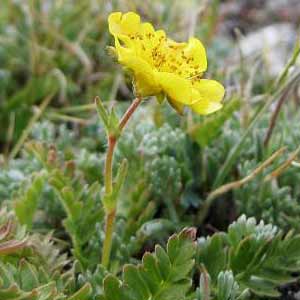Geum rossii
(synonym of Geum rossii var. depressum)
Geum vernum
Ross' avens
heartleaf avens, spring avens
4–28 cm, glabrous or downy, hairs to 1 mm, sometimes septate-glandular.
20–70 cm, pilose or sparsely pilose, hairs septate.
basal 3–13 cm, blade pinnate to interruptedly pinnate, major leaflets 13–26, alternating with 0–14 minor ones, terminal leaflet slightly larger than major laterals;
cauline 0.7–2 cm, stipules adnate to leaf, indistinguishable from pair of lobes, blade bractlike, not resembling basal, alternate, simple, pinnatifid to 3-fid.
basal 4–27 cm, blade simple or pinnate, leaflets 3–11, terminal leaflet larger;
cauline 2–7 cm, stipules ± free, 8–25 × 7–12 mm, blade pinnate to 3-foliolate.
1–3(–4)-flowered.
3–13-flowered.
woolly, sometimes glandular.
glandular-downy, becoming glabrate in fruit.
erect;
epicalyx bractlets 1.5–7 mm;
hypanthium green, slightly purple-tinged to strongly purple;
sepals erect to erect-spreading, 3–10 mm;
petals spreading, yellow, obovate to nearly orbiculate, 5–12(–17) mm, longer than sepals, apex broadly rounded to irregularly emarginate.
erect;
epicalyx bractlets absent;
hypanthium green;
sepals reflexed, 1–3 mm;
petals spreading, yellow to cream, oblong to elliptic, sometimes obovate, 1–2 mm, equal to or shorter than sepals, apex rounded.
sessile, glabrous.
on 3–7 mm stipes, glabrous.
wholly persistent, not geniculate-jointed, 2–5(–10) mm, apex not hooked, glabrous throughout or pilose only at base.
geniculate-jointed, proximal segment persistent, 1.5–3 mm, apex hooked, nearly glabrous except for few septate-glandular hairs, distal segment deciduous, 0.7–1 mm, nearly glabrous except for short hairs.
= 56.
= 42.
Geum rossii
Geum vernum
The variability accommodated here in Geum rossii was distributed by earlier monographers such as P. A. Rydberg (1913b) and F. Bolle (1933) among a half dozen species. W. Gajewski (1957) reduced them to two species, G. rossii and G. turbinatum; most recent taxonomists have recognized the two taxa as subspecies or varieties of a single species. The large geographic discontinuity between the Rocky Mountain and arctic ranges makes it easy for those wishing to follow this tradition. No one morphologic character or combination of characters neatly separates the arctic plants from those of the Rockies.
Where their ranges overlap in Alaska, Geum rossii hybridizes with G. calthifolium to form sterile plants known as G. ×macranthum (Kearney ex Rydberg) B. Boivin; see discussion under 4. G. schofieldii.
(Discussion copyrighted by Flora of North America; reprinted with permission.)
Geum vernum is distinctive and is recognized by its early flowering, minute petals, lack of epicalyx bractlets, and heads of achenes soon elevated well beyond the recurved hypanthia and sepals. Recently, it has been expanding its range northward and has been collected with increasing frequency in southern Ontario, Massachusetts, Michigan, New York, and Wisconsin. No specimens could be located to confirm reports of G. vernum from Mississippi or Texas.
(Discussion copyrighted by Flora of North America; reprinted with permission.)
- Local floras:
BC,
OR,
WA
- Local Web sites:
CalFlora,
CalPhotos,
Flora NW,
PNW Herbaria
WildflowerSearch
iNaturalist (observations)
USDA Plants Database
- LBJ Wildflower Center
- SEINet
- Plants of the World Online
- Encyclopedia of Life
- Wikipedia
- Google Image Search
